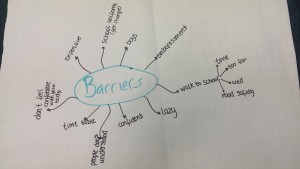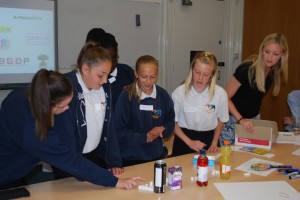Natalie Jester reflects on her
experiences of designing and delivering the Gender Research Centre's workshop
for local A Level students
What we did
When the call for proposals for the
ESRC-sponsored Thinking Futures Festival went out in 2014, the request for events targeted at ‘new audiences’ using ‘different engagement methods’ caught
my eye. I liked the idea of running an academic workshop with local school
pupils, so I suggested it to fellow members of the SPAIS Gender Research
Centre, and it was adopted as one of our centre’s proposals. I co-wrote the
successful application with Professor Jutta Weldes, and we held our first
Decoding Gender in the Media workshop in November 2014 with Thinking Futures
and the Schools University
Partnership Initiative, supported by Chloe Anderson. We felt that it went
well, so we applied to run the same workshop again in 2015, and it took place
in early November.
 |
A
Level students involved in the De-coding Gender workshop
|
Why we did it
When I first had the idea for this
workshop in 2014, one of the main things in my mind was this idea of ‘new
audiences.’ I really enjoy engaging with young people, although I didn’t have
much experience of it before our first workshop in 2014. It is a horrible
cliché, but young people really are the future. They are the ones who will be
producing our culture, running our government and our schools, so the way in
which they make sense of the world really does matter.
Teenagers are also in that
difficult space between childhood and adulthood, where they are trying to
figure out who they are. I remember being that age myself and having terrible
body image problems, so part of the motivation for running this workshop was to
give young people the tools with which they could deconstruct the media and say
precisely why it was rubbish. With tablets and
mobile phones making the media accessible 24/7, this is even more important
than ever.
 |
| Students present their findings to the rest of the group |
Lessons learned
Running this workshop two years in
a row has taught me many lessons, chiefly that nothing ever goes entirely to
plan, and you just have to be prepared to deal with that on the day. If you
expect traffic problems, illness, and to forget something you needed, you won’t
feel so worried when one of those things inevitably happens; just improvise.
Forgotten your name labels? Use post-it notes with sticky tape. Forgotten your
camera? Find someone with a good camera phone and use that. Secondly, I cannot
stress enough the importance of working with other people, specifically a team of
people you know you can rely on. Working on your own is more work, less fun and
more of a risk because if you are ill on the day there is no one else to step
in; a team is always better. Thirdly, everything requires more work than you
think it will, even the second time around, so start preparing early. This is
even more important because it mitigates the problems if something more serious
goes wrong. Finally, schools are not the easiest organisations to work with,
because they are so large and under pressure to hit targets, so you should
expect not to receive replies to all emails, and for some people to drop out
near/on the day. This is not something to be taken personally, but simply one
of the few down sides of working with complex organisations.
Nat Jester is a PhD student at the SPAIS
Gender Research Centre. Her PhD examines how UK state identity is constructed in
online British media representations of the conflict in Libya. Drawing on David
Campbell's work Writing Security, she examines the way identities are sculpted
around external threats, paying special attention to gendered-Orientalist tropes.










